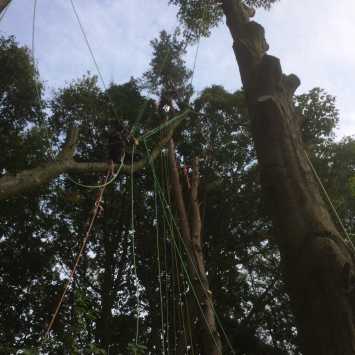Aerial Cutting & Rigging – Contracting links to training
We recently integrated two of our training courses, aerial cutting and rigging into commercial jobs. One of them was near our training site, in Wadhurst East Sussex and the other in Ide Hill, Kent.
Our popular tree surgery training courses equip students with the basic skills required, to build upon over hopefully a long and safe career free from major injury or typical muscular skeletal issues.
We try to combine training and commercial jobs in an intelligent way, so that some of the commercial aspects and feel are brought into focus but without any pressure to finish a job. Recently we had a couple of ideal jobs that allowed students on both rigging and aerial cutting to see the application of their improving skills and techniques in a live site.
On the rigging course we used our Straightpoint loadcell to gather data on section mass, anchor point and line loads. A client near to the training site in Lamberhurst wanted 4 medium oaks and an ash tree crown raised, together with major deadwood removed. This was ideal for an aerial cutting course on days 2 and 3 after an initial day of theory, demonstrations and individual practice at the training site. The only target was a chestnut pailing fence and the client was really pleased with the result.
Another job we undertook was for a Domestic Chainsaw Training client with a woodland garden. They wanted a couple of red oaks and a scots pine removed and were ideally suited to a rigging course. This was due to the fact that they had a range of shrubs below and a play fort in one area, so representative targets but not a unrealistic for training.
The oaks were fairly similar in character and size so the trainees took turns to remove sections. The scots pine had a mid level split to 2 stems which potentially made it weaker, so this was tackled by the normal team after taking precautions to strap the stems together. Rigging control was also critical on this tree and the Good Rigging Control System (GRCS) was used to allow a fast and smooth descent with the aim being to control the butt end, but minimise the anchor point loading. The team also discussed other options including rigging it from the top in order to avoid force multiplication.
Incorporating friction at the top of the tree with rigging rings and the rigging wrench is now becoming fashionable again. Check out the HSE Rigging Research for more information on rigging operations.
The scots pine had a weak fork so we used a combination of techniques to make this tree safer to work on and used it for demonstration only, not trainee practice.
Here a few of the benefits -
- New site – allows students to think about their preparations in terms of work planning and risk assessment for themselves, then have input from the team. It can encourage trainees to take ownership of these initial steps.
- Real challenges in ground obstacles – low to medium value targets are good to work around, such as fences and play forts. Obviously we would not choose sites with higher value targets or ones where extra hazards were added.
- Introductory demonstrations supplemented but ongoing more technical demonstrations. Often, trainees benefit with a mid course demo – maybe a more advanced technique or an opportunity to solve a problem by allowing the instructor to take over and continue with the work for a limited time.
- In tree commentary on multi tree jobs. In Ide Hill we had several trees in close proximity to work on which allowed trainees to be near enough to get some live tree level input. This is often a better vantage point to offer suggestions on anchor points and section removal order.
- Ideas about follow on services to add value – such as stump removal, planting, on site milling, log splitting and building a log store were all part of the follow on work to be completed for these customers.
If you have any questions about our tree climbing training or chainsaw training courses, please get in touch with us to discuss - We'd love to hear from you!



